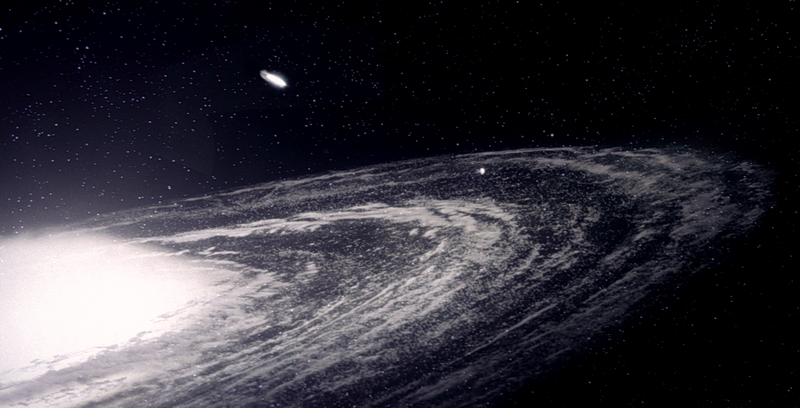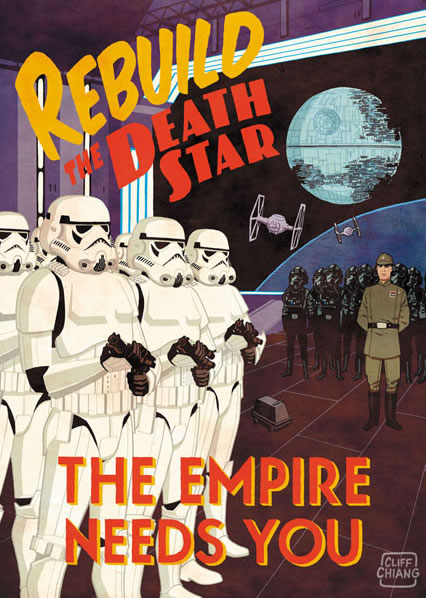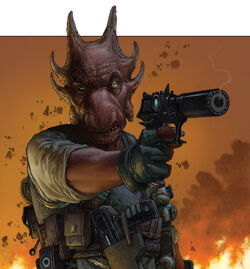
Our own galaxy, the Milky Way, has this killer statistic:
“contains approximately 100–400 billion stars”
At least according to its wiki page and, all things considered, there’s no reason to think that estimate is inaccurate. Or, to put it another way, in far more succinct and famous fashion, The Hitchhiker’s Guide to Galaxy has this:
“Space,” it says, “is big. Really big. You just won’t believe how vastly, hugely, mindbogglingly big it is. I mean, you may think it’s a long way down the road to the chemist’s, but that’s just peanuts to space.”
And it is more than likely the galaxy that is home to Star Wars is similar; even if it was a quarter of the size of the Milky Way that’s still 25 billion stars, all with planetary systems of one kind or another.
Now add in time – the Milky Way is thought to be 13.2 billion years old, the Star Wars galaxy is similar and we have stories set across 35-37 millennia! 35-37,000 years! In but a couple of millennia civilizations of all kinds have risen and fallen, Star Wars is no different – yet you wouldn’t know it from the way its stories have been told for the last few years.
We have this wide, expansive, incredibly old yet, in galactic terms, probably still young galaxy, but Star Wars has taken a reduction route. It’s boiled its galaxy down to a number of set patterns, with little in the way of difference being tolerated. When something does step out of line, corrective action is taken to get it back into line and nowhere is this more apparent than in the Jedi. You would think, logically, there would be many different Jedi orders across the centuries, with unique structures. You would be wrong.
Despite setting up Luke Skywalker to restore the Jedi, in a way distinct from its destroyed predecessor, the Expanded Universe just can’t seem to help itself with having Luke apply terms like Padawan to the revived order in the New Jedi Order to later reviving the Jedi Council. Why do this when those ideas were found wanting? Because it’s got to be the same!

There are numerous accounts of why Anakin Solo had to die in the New Jedi Order, all agree on one point: the idea was that the audience would be confused by the name similarity to Anakin Skywalker! Really? Seriously? Apparently so. This does not bode well because if it is thought that the audience will be confused by similar names then what of different iterations of the Jedi, Sith and Empire?
Yet, it isn’t just in the New Jedi Order arc that this happens. Nope, for all its brilliance, the Knights of the Old Republic game went and added a Jedi Council to the Tales of the Jedi era. The comics produced 1993-1998 had the Jedi as operating more informally, with gatherings of Jedi being a rare event. Yet, a handful of decades later, there’s a Jedi Council structure in place. In all likelihood, this was done to reflect the Prequels’ structure, as it was The Phantom Menace in 1999 that showed us the Jedi Council and the KOTOR game came out 2003. Even the recent story, Dawn of the Jedi, set millennia earlier still has a Council present, it’s as if an idea present in one era must be present in all eras!
Nor is the Empire immune – as the recent The Old Republic shows – here, despite being set millennia before the films, there’s some remarkably similar aesthetics being displayed! TIE fighters? Star Destroyers? What the hell are they doing there? At least in the Legacy comics there is a clear historical continuity, with the Empire there being the one from the films roughly a century on. So, you have a reason for the designs being next generation TIEs and Star Destroyers. Featuring them much earlier just doesn’t work at all.
 And the Sith…. Ah, the Sith must be feeling like a nice Single Malt whiskey that’s had a measure of ice to shot that’s about 500%! If you did this, you would end up with something little more than water, all that made it whiskey would have been diluted out! So it has become with the Sith – you want an army of red lightsaber swinging bad dudes? Easy, there’s loads of them hanging around the place – just entirely forgotten about.To be fair Legacy‘s Sith, in the comics, have a fair amount of variance, but The Old Republic? It’s an army headed by an Emperor type, KOTOR has but two Sith Lords, clearly echoing the prequels’ notion. Vader? Well, as an enforcement heavy, Darth Malak does look the part.
And the Sith…. Ah, the Sith must be feeling like a nice Single Malt whiskey that’s had a measure of ice to shot that’s about 500%! If you did this, you would end up with something little more than water, all that made it whiskey would have been diluted out! So it has become with the Sith – you want an army of red lightsaber swinging bad dudes? Easy, there’s loads of them hanging around the place – just entirely forgotten about.To be fair Legacy‘s Sith, in the comics, have a fair amount of variance, but The Old Republic? It’s an army headed by an Emperor type, KOTOR has but two Sith Lords, clearly echoing the prequels’ notion. Vader? Well, as an enforcement heavy, Darth Malak does look the part.
Yet why is this strange monomania in place at all? If it truly is due to the expectation that the audience will be confused by a lack of consistency, then Star Wars is in a dire mess. This is a world where Marvel have spun a story line across five movies, brought it to a resounding conclusion in Avengers and are now on Act 2. They didn’t do that by having low expectations of the audience. Instead they assumed a level of intelligence and that was rewarded. It’s a world where the big successful TV series are spinning labyrinthine plots, with large casts of very well-realized characters, across multiple series.
It might be said that this is an attempt to create a consistency that is familiar to the audience who have only seen the films. True, some consistency is expected, but when the story is set far earlier than the films surely the consistency expected will be more thematic than literal transplanting? Go too far from the films and the story loses that which makes it a Star Wars property, but don’t depart at all and you get a carbon copy that can surprise and intrigue no one.
Will Disney’s takeover see a change? It’s very hard to say. My own suspicion is that, given fan response across the internet to some stories, Disney’s response will be to be more careful and conservative so there will be less room for experimentation and innovation. Still, perhaps I’ll be mistaken and Disney does decide to really run with the property they’ve got – a story that can be told on a galactic scale across millennia!

 A couple of days back I grabbed Jeffrey Brown’s trio of Star Wars books for a bargain price and, after getting them delivered, went through them pretty quick. His latest is Jedi Academy, but it’s the preceding books, Darth Vader and Son and Vader’s Little Princess that really got him attention and deservedly so.
A couple of days back I grabbed Jeffrey Brown’s trio of Star Wars books for a bargain price and, after getting them delivered, went through them pretty quick. His latest is Jedi Academy, but it’s the preceding books, Darth Vader and Son and Vader’s Little Princess that really got him attention and deservedly so.



 And the Sith…. Ah, the Sith must be feeling like a nice Single Malt whiskey that’s had a measure of ice to shot that’s about 500%! If you did this, you would end up with something little more than water, all that made it whiskey would have been diluted out! So it has become with the Sith – you want an army of red lightsaber swinging bad dudes? Easy, there’s loads of them hanging around the place – just entirely forgotten about.To be fair Legacy‘s Sith, in the comics, have a fair amount of variance, but The Old Republic? It’s an army headed by an Emperor type, KOTOR has but two Sith Lords, clearly echoing the prequels’ notion. Vader? Well, as an enforcement heavy, Darth Malak does look the part.
And the Sith…. Ah, the Sith must be feeling like a nice Single Malt whiskey that’s had a measure of ice to shot that’s about 500%! If you did this, you would end up with something little more than water, all that made it whiskey would have been diluted out! So it has become with the Sith – you want an army of red lightsaber swinging bad dudes? Easy, there’s loads of them hanging around the place – just entirely forgotten about.To be fair Legacy‘s Sith, in the comics, have a fair amount of variance, but The Old Republic? It’s an army headed by an Emperor type, KOTOR has but two Sith Lords, clearly echoing the prequels’ notion. Vader? Well, as an enforcement heavy, Darth Malak does look the part.
 Perhaps better to ask what characters there are that are deemed as equal to the lead human characters? In this respect, it seems the best examples in recent years can be found in comics. Knights of the Old Republic alone gives us two very well-realized characters in the form of Jarael and Gryph, the latter of which has his own fanbase! Dark Times has Bomo and the crew of the Uhumele, all well-done characters. In both cases we don’t see either Zayne Carrick or Jass Dennir attempting to steamroller them into submission, although it isn’t in their character to do so. Stazi, already mentioned, tends to take center stage in any story he’s in and then there’s Jedi Master K’Krukh…
Perhaps better to ask what characters there are that are deemed as equal to the lead human characters? In this respect, it seems the best examples in recent years can be found in comics. Knights of the Old Republic alone gives us two very well-realized characters in the form of Jarael and Gryph, the latter of which has his own fanbase! Dark Times has Bomo and the crew of the Uhumele, all well-done characters. In both cases we don’t see either Zayne Carrick or Jass Dennir attempting to steamroller them into submission, although it isn’t in their character to do so. Stazi, already mentioned, tends to take center stage in any story he’s in and then there’s Jedi Master K’Krukh…